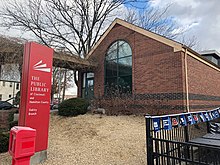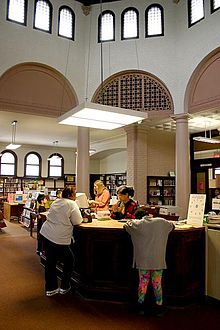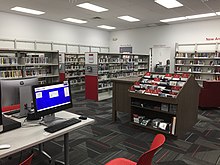Cincinnati and Hamilton County Public Library
 | |
| Country | United States |
|---|---|
| Established | March 14, 1853[1] |
| Location | Cincinnati and Hamilton County, Ohio |
| Coordinates | 39°6′18″N 84°30′48″W / 39.10500°N 84.51333°WCoordinates: 39°6′18″N 84°30′48″W / 39.10500°N 84.51333°W |
| Branches | 41 |
| Collection | |
| Size | 9.6 million[2] |
| Legal deposit | Selective federal depository library[3] |
| Access and use | |
| Circulation | 21 million[4] |
| Population served | 845,303 |
| Members | 489,258 active[4] |
| Other information | |
| Budget | US$80.5 Million[5] |
| Director | Paula Brehm-Heeger |
| Website | http://www.cincinnatilibrary.org/ |
| Map | |
 | |








Cincinnati and Hamilton County Public Library (CHPL) is a public library system in the United States. In addition to its main library location in downtown Cincinnati, Ohio, CHPL operates 40 regional and branch locations throughout Hamilton County.
As of 2016, the CHPL's collection held nearly 9 million volumes and nearly 12 million items, the 13th-largest overall library collection in the U.S.[6][7] and the 2nd-largest public library collection in the U.S.[7] Its electronic book holdings were nearly six million, the most of any public library in the country.[7]
In 2019, CHPL had an annual circulation of over twenty-one million items, the second highest circulation of any public library in the country.[4] The downtown location alone circulates over four million items annually, the most of any single library location in the country, and has an area of 542,527 square feet (50,402.4 m2).[8][9] CHPL's various locations had 5,154,502 visitors in 2019.[10]
The library first received Library Journal's highest rating of five stars in 2013, and has received the honor every year since. In 2020, it scored second in the nation among libraries with expenditures over US$30 million.[11]
Services[]
Among CHPL's collections are books, audiobooks, downloadable digital audio and e-books, magazines, newspapers, CDs, videos, DVDs, CD-ROMs, sheet music, slides, microfilm, microfiche, and Braille. It offers free in-building computer access and Wi-Fi, as well as loaning Wi-Fi hotspots for use at home. The system collectively offered over 17,000 free programs in 2019, including classes, lectures, book clubs, performances, storytimes, and much more. In 2019, its staff answered 1.6 million reference questions by phone, online chat, fax, e-mail, post, and in person. The Main Branch is a selective federal depository library.[3]
The library's website provides access to the library catalog, nearly 150 commercial research databases, bestseller lists, staff reading recommendations, and other information resources.
Special needs services provided by CHPL include "talking books" and Braille to the visually impaired, blind, and physically handicapped in 33 Ohio counties; its outreach services include books-by-mail, foreign language materials and bilingual programs, and passport application; its literacy services include GED classes and GED practice testing.
CHPL holds one of the largest genealogical collections in the United States. Online postings include Cincinnati and Norwood, Ohio city directories, Sanborn maps, and yearbooks as well as books relating to local history.
In 2015, the Library opened its first MakerSpace at the Main Library downtown, offering button makers, 3D printers, sewing machines, laser engraving, photography equipment, a recording booth, and more. Later that year, branch MakerSpaces also opened at the Reading and St. Bernard locations, and renovations at the Loveland branch in 2016 included opening a fourth MakerSpace.
Special Collections[]
In addition to its large book collection, the Library also has many specialized collections, most of which are housed in the main library. Highlights of special book collections include:[12]
- Adult New Reader/English as a Second Language Collections
- Braille Books
- Contemporary Artists’ Books
- Jean Alva Goldsmith Children's Literature Collection[13]
- Jobs Information Center Collection
- Science Fair Project Collection
- Murray Seasongood Collection of Government, Law and Public Administration
- Theological and Religious Collection
History[]
CHPL traces its roots to a subscription library that began in 1802. On March 14, 1853, it became the Cincinnati Public Library.[1] Since its founding, the library has occupied several locations, including its current location at Eighth Street and Vine Street.[14]

Cincinnati's public library was among the first to try providing service to patrons on Sunday. Starting in March 1871, the reading rooms at the main library were open from 8am to 10pm. Sunday library service was so popular that, according to library director William F. Poole, "often during the afternoon and evenings every seat has been occupied". As a result of Cincinnati's experiment, the public libraries in New York, Philadelphia, and St. Louis adopted Sunday hours as well. Poole reported that "many of that class of young men who [had previously] strolled about the streets on Sunday, and spent the day in a less profitable manner, [began] habitually frequenting the rooms and spending a portion of the day in reading."[15]
Beginning in the early 1990s, the library used the Computerized Information Network for Cincinnati and Hamilton County (CINCH) as a system-wide library catalog which connected each branch through computer terminals.[16][17] Users at home accessed the database via TELNET. In 2005, the system was replaced with an integrated library system (ILS) purchased from library automation vendor Sirsi, now SirsiDynix. In 2012, the ILS was again replaced with Sierra, a product from Innovative Interfaces.
Beginning in 2001, budget cuts from the State of Ohio drastically reduced funding for CHPL. In July 2002, the Board of Trustees voted to close branch locations in Deer Park, Elmwood Place, Greenhills and Mount Healthy. The board later backed off on the branch closing plan after a strong negative response from citizens in the affected neighborhoods.[18]
In 2005, the library received the American Library Association's John Cotton Dana Public Relations Award.
In 2005, a state budget plan that cut spending on libraries a further five percent was passed in the Ohio House of Representatives, after being proposed by Ohio governor Bob Taft. The budget prompted the library to distribute flyers and hold rallies in Downtown Cincinnati, calling on the state to repeal the proposed cuts.[19] The cuts resulted in a periodic hiring freeze, reductions in hours, branch and department closings, and the layoff of approximately forty librarians. Librarians responded by voting to join the Service Employees International Union (SEIU) Local 1199 in 2006.[20]
After nine months of contentious negotiations over a union contract, the parties (SEIU and the library administration) resorted to a hearing in front of a third-party neutral negotiator, who drew up a labor contract. Librarians voted 45–1 to approve the contract. The library's Board of Trustees subsequently voted the contract down by a 7–0 vote, citing concerns over 'fair share' proposals built into the contract. After further negotiations between SEIU and attorneys for the library, the Board approved a union contract that did not include fair share. See the Agency shop article for clarification.[citation needed]
In 2007, the library began implementing a reorganization plan, known as ML/21 (Main Library for the 21st Century), to plan the creation of a Technology Center, Teen Center, a Popular Library, and a Local History and Genealogy Department. The plan also called for the disbanding of subject departments in Art and Music, Literature and Languages, History and Genealogy, Rare Books and Special Collections, Science and Technology, Government and Business, Education and Religion, Fiction and Young Adults, and Films and Recordings. The latter two departments were planned to be incorporated into a new Popular Library. The History and Genealogy Department were planned to be merged with Rare Books and Special Collections to create the Local History and Genealogy department. The other subject departments were planned to be merged into the Information and Reference department. Approximately 24 professional positions (those holding a Master of Library and Information Science) were slated for elimination through attrition and reassignment.[21][22][23]
From July 2007 to mid 2008, the library joined with to digitize rare books and make them available via Amazon.com. The library no longer participates in the program, but profits from sales of the digitized books were shared with the library. Other institutions involved in the plan included the University of Maine, Emory University in Atlanta, and the Toronto Public Library in Ontario.[24] Digitized material, including books, maps, yearbooks, and city directories, are available via Cincinnati and Hamilton County Public Library's Virtual Library.
In 2019, the library launched a multi-year improvement project called "Building the Next Generation Library." The project planned for facility improvements across the system depending on the needs of communities and facilities. Listening sessions were held for community members at each branch throughout 2019, and the Facility Master Plan documents outlined the recommended work to be done over the next 10 years.[25] Part of the Next Generation Library initiative included a website and brand update in 2020, with the library moving to a BiblioCommons-based website and revealing new logos, brand colors, and the rearranged organization name from The Public Library of Cincinnati and Hamilton County to Cincinnati and Hamilton County Public Library.[26] Some priorities were modified due to the 2020 COVID-19 pandemic.[27]
Directors[]
Fifteen individuals have served as Directors of Cincinnati and Hamilton County Public Library:[1]
- John D. Caldwell (1855–1857)
- N. Peabody Poor (1857–1866)
- Lewis Freeman (1866–1869)
- William Frederick Poole (1869–1873)
- Thomas Vickers (1874–1879)
- Chester W. Merrill (1880–1886)
- Albert W. Whelpley (1886–1900)
- Nathaniel D.C. Hodges (1900–1924)
- Chalmers Hadley (1924–1945)
- Carl Vitz (1946–1955)
- Ernest I. Miller (1955–1971)
- James R. Hunt (1971–1991)
- Robert D. Stonestreet (1991–1998)
- Kimber L. Fender (1999–2018)
- Paula Brehm-Heeger (2018–present)[28]
List of branches[]
CHPL has 40 branch locations, in addition to the main library downtown:



- Anderson Branch
- Avondale Branch*
- Blue Ash Branch (formerly the Sycamore Branch)
- Bond Hill Branch
- Cheviot Branch
- Clifton Branch
- College Hill Branch (formerly the Northern Hills Branch)
- Corryville Branch* (formerly the North Cincinnati Branch)
- Covedale Branch
- Deer Park Branch
- Delhi Township Branch
- Elmwood Place Branch
- Forest Park Branch (formerly the Parkdale Branch)
- Green Township Regional Branch
- Greenhills Branch
- Groesbeck Branch
- Harrison Branch
- Hyde Park Branch*
- Loveland Branch
- Madeira Branch (formerly the Madeira–Indian Hill Regional Branch)
- Madisonville Branch
- Mariemont Branch
- Miami Township Branch (originally the Cleves Branch)
- Monfort Heights Branch (formerly the West Fork Branch)
- Mt. Healthy Branch
- Mt. Washington Branch
- North Central Branch
- Northside Branch* (formerly the Cumminsville Branch)
- Norwood Branch*
- Oakley Branch
- Pleasant Ridge Branch
- Price Hill Branch*
- Reading Branch (formerly the Valley Branch)
- St. Bernard Branch
- Sharonville Branch
- Symmes Township Regional Branch
- Walnut Hills Branch*
- West End Branch (formerly the Lincoln Park Branch)
- Westwood Branch
- Wyoming Branch (formerly the Bonham Branch)
Locations marked with asterisks were built as Carnegie libraries.[29]
See also[]
- John Reily, one of the original subscribers
- The Public, a 2018 film set in the library's Main branch[30]
References[]
- ^ Jump up to: a b c Fleischman, John (November 2002). Free & Public: One Hundred and Fifty Years at the Public Library of Cincinnati & Hamilton County, 1853–2003. Wilmington, Ohio: Orange Frazer Press. ISBN 1-882203-91-7. Archived from the original on May 19, 2011. Retrieved January 16, 2007.
- ^ "The Public Library of Cincinnati & Hamilton County Regular Audit for the Year Ended December 31, 2019" (PDF). Cincinnati, Ohio: Ohio Auditor of State. Retrieved December 31, 2020.
- ^ Jump up to: a b "Ohio". GPO Federal Library Directory. United States Government Printing Office. Retrieved September 23, 2008.
- ^ Jump up to: a b c "Statistics". Cincinnati, Ohio: Cincinnati and Hamilton County Public Library. Retrieved December 31, 2020.
- ^ "The Public Library of Cincinnati & Hamilton County Facilities Master Plan Report Part I" (PDF). Cincinnati, Ohio: Public Library of Cincinnati and Hamilton County. December 9, 2019. Retrieved December 31, 2020.
- ^ "The Nation's Largest Libraries: A Listing By Volumes Held". Retrieved February 22, 2017.
- ^ Jump up to: a b c "The Nation's Largest Public Libraries". American Library Association. Retrieved February 4, 2021.
- ^ Brogan, Jeff (November 26, 2008). "Downtown Library Rated The Country's Busiest". WCPO-TV. E. W. Scripps Company. Retrieved November 26, 2008.[permanent dead link]
- ^ "About the Building". Cincinnati and Hamilton County Public Library. Retrieved December 31, 2020.
- ^ "Statistical Report-November 2020" (PDF). Cincinnati, Ohio: Cincinnati and Hamilton County Public Library. December 8, 2020. Retrieved December 31, 2020.
- ^ Lance, Keith Curry. "2020 Star Libraries By the Numbers | LJ Index 2020". Library Journal. Retrieved December 31, 2020.
- ^ Special Collections & Indexes - Book Collections. Accessed 2019-03-10.
- ^ Jean Alva Goldsmith Collection. Accessed 2019-03-10
- ^ Seavey, Charles (2001). "Cincinnati Public Library Archived January 15, 2002, at archive.today." Images From The 1876 Report. Columbia, MO: University of Missouri. Accessed July 8, 2005.
- ^ "Library opening on Sunday; results in Cincinnati". New York Times. July 1, 1872. p. 5.
- ^ Felix Winternitz & Sacha DeVroomen Bellman (2007). Insiders' Guide to Cincinnati. Globe Pequot. p. 370. ISBN 9780762741809. Retrieved May 8, 2013.
- ^ "Fifty Years of Friends" (PDF). Cincinnati, Ohio: Friends of the Public Library of Cincinnati & Hamilton County. October 2007. Retrieved December 31, 2020.
- ^ Korte, Gregory (August 10, 2002). "Library Didn't See Squeeze Coming". The Cincinnati Enquirer. p. A1.
- ^ "Cincinnatians Speak Out against State Budget Cuts". American Libraries Online. American Library Association. April 22, 2005. Retrieved June 28, 2005.
- ^ "Librarians Vote in Favor of Forming Labor Union". The Cincinnati Enquirer. January 31, 2006. p. 2B.
- ^ “Board Approves Moving Forward on Main Library for the 21st century Plan” 2006-11-30 Accessed March 16, 2007.
- ^ Kurtzman, Lori (December 5, 2006). "Main Library Ready for New Chapter with Service Overhaul". The Cincinnati Enquirer. p. C3.
- ^ Journal, Library. "Changes at Cincinnati's New Main". Library Journal. Retrieved February 4, 2021.
- ^ Doloff, Aimee (July 7, 2007). "UM Reaches Deal to Make Digital Copies of Rare Books". Bangor Daily News.
- ^ "Building the Next Generation Library". Cincinnati, Ohio: Cincinnati and Hamilton County Public Library. Retrieved December 31, 2020.
- ^ Rinehart, Bill. "Cincinnati Library Ready To Open A New Chapter". www.wvxu.org. Retrieved February 4, 2021.
- ^ Brehm-Heeger, Paula (October 27, 2020). "Progress Update: Building the Next Generation Library". Cincinnati, Ohio: Cincinnati and Hamilton County Public Library. Retrieved December 31, 2020.
- ^ Cincinnati Public Library announces new director
- ^ Andry, Al (October 11, 1999). "New life for historic libraries". The Cincinnati Post. E. W. Scripps Company. Archived from the original on September 30, 2007. Retrieved November 12, 2007.
- ^ Peet, Lisa. "Midwestern Libraries Grapple with Polar Vortex". Library Journal. Retrieved November 7, 2019.
External links[]
| Wikimedia Commons has media related to Public Library of Cincinnati and Hamilton County. |
- Cincinnati and Hamilton County Public Library
- CHPL online catalog
- Kidspace – library website for children
- Teenspace – library website for teenagers
- Friends of the Public Library Archived May 2, 2012, at the Wayback Machine
- Rearranging the books Citybeat article on library reorganization plan
- Ml/21 Library's webpage on library reorganization plan
- Cincinnati Panorama of 1848 The library holds a rare daguerreotype of the buildings along the Ohio River in 1848.
- Public libraries in Ohio
- Organizations established in 1853
- 1853 establishments in Ohio
- Federal depository libraries
- Carnegie libraries in Ohio
- Education in Cincinnati
- Non-profit organizations based in Cincinnati

